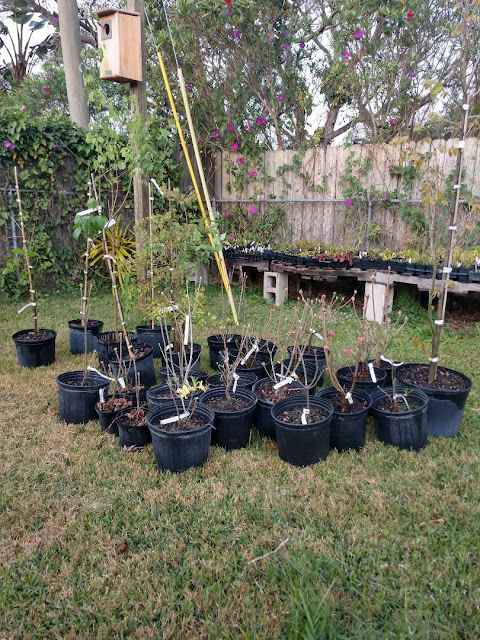Beginning the Woodland - The Foundation Trees and Shrubs
 |
| The Foundation Trees and Shrubs for the New Woodland |
 |
| The Remaining Woody Plants (Mostly) |
The choice on where to locate my woodland was simple. I've made the mistake in the past of putting too much shade on my pollinator/wildflower gardens. This time, I am completely separating the trees and shrubs from the wildflowers - at least separating the two very different landscapes from each other. My backyard woodland will mostly be for birds, though it has some significant species for pollinators. It is on the north side of the property so it won't add much shade to my pergola filled with my orchid collection or to the newly finished created wetland that I've previously written about.
It will be deciduous because I want sunlight in the understory during the late fall and through the winter. If there is a real fall cool down, I'll also appreciate some fall color. Here where I live in Florida, the emphasis seems to be on evergreen species. I will never understand that as I love seeing the change of seasons and I love the sunlight after the weather cools in the late fall.
I have always been impatient. Even as I've aged, I find myself wanting to get all of these plants in the ground as quickly as possible. Seeing the pots sitting in the backyard is chafing, however, I've learned that taking a slow and reasoned approach is the only way to get the full potential out of the plants I have.
I've decided to anchor my new woodland with only one tall canopy tree. In the past, I've used several for this purpose, but I don't want a tall woodland. The remaining trees are technically better described as subcanopy ones. They will likely never get taller than 30-40 feet; most significantly less than that.
I've chosen an American basswood (Tilia americana) as my one tall tree. This species occurs naturally in my geographic region, though I am at the southern edge and it should prosper in the conditions I've given it. Basswoods are strong upright trees and their spring flowers are both fragrant and of great interest to bees and other pollinators. It's branch structure should support the nesting of various songbirds and it will develop quick enough that I should see some of these results before I pass on........
 |
| The basswood planted |
 |
| I love its leaves |
This woodland, more than any other I've planted, will reflect my sensibilities and aesthetics. Starting over, in an urban desert like I have, is allowing me complete freedom to add the species which I've most come to admire during my nearly 35 years here in central Florida. There are things I wish I could add, but they are either unavailable or just plain wrong for this site. My current list are species I am hopeful about even though a few are outside their geographic range - but so are most plants used in Florida landscapes as they come from the tropics thousands of miles away.
I will be adding a few more hawthorns (Crataegus spp.) to the woods, even though I have added five species to the sunny front yard. I have set aside some parsley and Washington haws (C. marshallii and C. phaenopyrum, respectively). The latter will have to go on the edges. I've purchased some downy serviceberries (Amelanchier arborea) because I love everything about them. I've also picked up some silverbells (Halesia distera and H. caroliniana) because I've grown to love them almost as much as my fringe trees (Chionanthus virginicus). I have yet to purchase a flatwoods plum (Prunus umbellata), but I expect to rectify that in a couple of weeks when I attend a native plant sale near me and I've set aside a beautiful specimen of the ultimate bird and pollinator understory tree - sparkleberry (Vaccinium arboreum). I've got a red buckeye (Aesculus pavia) for the hummingbirds that I hope to someday persuade in and about nine Florida flame azaleas (Rhododendron austrinum) and three Alabama azaleas (R. alabamense) for the same purpose. These are the most "iffy" of my new plants, but I've had success before and it seemed worth the try again. Last, I have a few of my favorite viburnums for nectar and bird fruit - rusty (Viburnum rufidulum) and mapleleaf (V. acerifolium). Both of these can produce spectacular fall color, have large heads of bright white flowers, and fruit that is more sought-after by birds than the other viburnums, native or not, that are more routinely planted here.
I'll be posting as I move forward and I'll be documenting the changes that I see. It may be several years, but it will be a most-rewarding journey.




Comments
Post a Comment